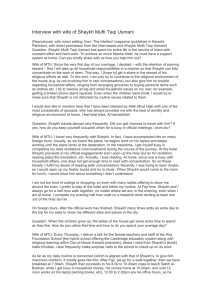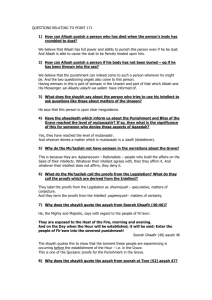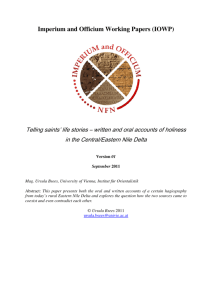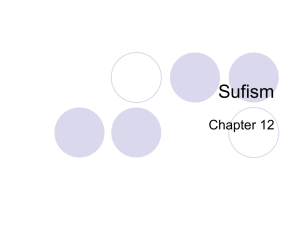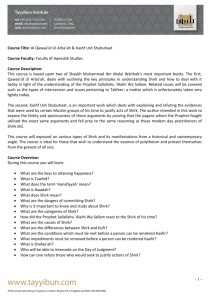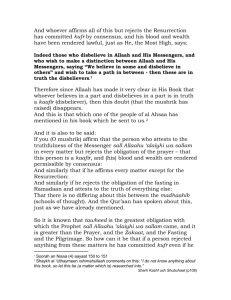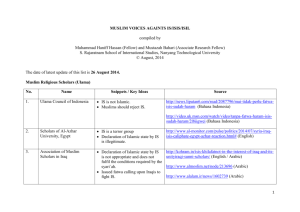Document 10464589
advertisement
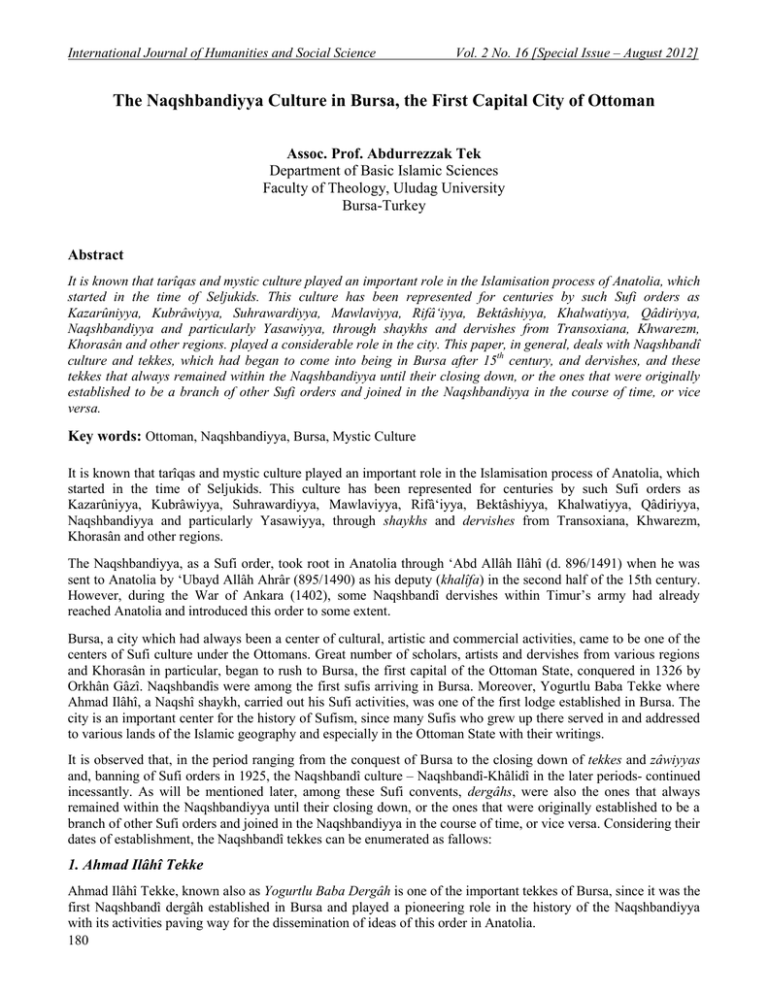
International Journal of Humanities and Social Science Vol. 2 No. 16 [Special Issue – August 2012] The Naqshbandiyya Culture in Bursa, the First Capital City of Ottoman Assoc. Prof. Abdurrezzak Tek Department of Basic Islamic Sciences Faculty of Theology, Uludag University Bursa-Turkey Abstract It is known that tarîqas and mystic culture played an important role in the Islamisation process of Anatolia, which started in the time of Seljukids. This culture has been represented for centuries by such Sufi orders as Kazarûniyya, Kubrâwiyya, Suhrawardiyya, Mawlaviyya, Rifâ‘iyya, Bektâshiyya, Khalwatiyya, Qâdiriyya, Naqshbandiyya and particularly Yasawiyya, through shaykhs and dervishes from Transoxiana, Khwarezm, Khorasân and other regions. played a considerable role in the city. This paper, in general, deals with Naqshbandî culture and tekkes, which had began to come into being in Bursa after 15th century, and dervishes, and these tekkes that always remained within the Naqshbandiyya until their closing down, or the ones that were originally established to be a branch of other Sufi orders and joined in the Naqshbandiyya in the course of time, or vice versa. Key words: Ottoman, Naqshbandiyya, Bursa, Mystic Culture It is known that tarîqas and mystic culture played an important role in the Islamisation process of Anatolia, which started in the time of Seljukids. This culture has been represented for centuries by such Sufi orders as Kazarûniyya, Kubrâwiyya, Suhrawardiyya, Mawlaviyya, Rifâ‘iyya, Bektâshiyya, Khalwatiyya, Qâdiriyya, Naqshbandiyya and particularly Yasawiyya, through shaykhs and dervishes from Transoxiana, Khwarezm, Khorasân and other regions. The Naqshbandiyya, as a Sufi order, took root in Anatolia through ‘Abd Allâh Ilâhî (d. 896/1491) when he was sent to Anatolia by ‘Ubayd Allâh Ahrâr (895/1490) as his deputy (khalîfa) in the second half of the 15th century. However, during the War of Ankara (1402), some Naqshbandî dervishes within Timur’s army had already reached Anatolia and introduced this order to some extent. Bursa, a city which had always been a center of cultural, artistic and commercial activities, came to be one of the centers of Sufi culture under the Ottomans. Great number of scholars, artists and dervishes from various regions and Khorasân in particular, began to rush to Bursa, the first capital of the Ottoman State, conquered in 1326 by Orkhân Gâzî. Naqshbandîs were among the first sufis arriving in Bursa. Moreover, Yogurtlu Baba Tekke where Ahmad Ilâhî, a Naqshî shaykh, carried out his Sufi activities, was one of the first lodge established in Bursa. The city is an important center for the history of Sufism, since many Sufis who grew up there served in and addressed to various lands of the Islamic geography and especially in the Ottoman State with their writings. It is observed that, in the period ranging from the conquest of Bursa to the closing down of tekkes and zâwiyyas and, banning of Sufi orders in 1925, the Naqshbandî culture – Naqshbandî-Khâlidî in the later periods- continued incessantly. As will be mentioned later, among these Sufi convents, dergâhs, were also the ones that always remained within the Naqshbandiyya until their closing down, or the ones that were originally established to be a branch of other Sufi orders and joined in the Naqshbandiyya in the course of time, or vice versa. Considering their dates of establishment, the Naqshbandî tekkes can be enumerated as fallows: 1. Ahmad Ilâhî Tekke Ahmad Ilâhî Tekke, known also as Yogurtlu Baba Dergâh is one of the important tekkes of Bursa, since it was the first Naqshbandî dergâh established in Bursa and played a pioneering role in the history of the Naqshbandiyya with its activities paving way for the dissemination of ideas of this order in Anatolia. 180 The Special Issue on Commerce and Social Science © Centre for Promoting Ideas, USA www.ijhssnet.com The Dergâh was established in the Eski Kaplıca Yolu (Road to Old Spa ), by a majzûb (ecstatic dervish obsessed by divine love) whose real name and origin is unknown, but nicknamed as Yogurtlu Baba (Father with yogurt) since he loved yogurt or doled out buttermilk to the soldiers during the conquest of Bursa. Yogurtlu Baba, who until his death led a solitary life in a cell of his dergâh following the conquest, was buried around the masjîd by his dergâh1. The most eminent shaykh of Yogurtlu Baba Dergâh was Ahmad Ilâhî, a Sufi of 15th century. His life before his arrival in Anatolia is unknown. However, some sources mention him to have been from Bukhara and to have served some shaykhs from Khalwatiyya, Malâmatiyya and Naqshbandiyya orders and become a successor to them. Ilâhî is most likely to have met Yâ‘kûb Charkhî (d. 851/1447) or ‘Ubayd Allâh Ahrâr (d. 893/1490) from the Naqshbadî shaykhs before his death. As far as the sources are concerned, Ahmad Ilâhî who is reported to have come to Bursa in the reign of Mehmed the Conqueror, restored the Yogurtlu Baba Dergâh which was then in ruins. Later on, a man of charity named Defterzâde Dervish Efendî from his followers rebuilt the Dergâh to serve dervishes.2 Furthermore, he built in the same place, a zâwiyya, a mosque and rooms for dervishes, and stipulated that the disposition of the tekke would be carried out by the sons of Ahmad Ilâhî. If the construction date of the tekke, 870/1465, in Bursa Kütüğü (Bursa Registers) is taken into consideration, the shaykh must have come to Anatolia before the time mentioned3. Although Ahmad Ilâhî is known to have been buried in the cemetery of his tekke, presently there exist no tekke building, graveyard or a tombstone4. His most well known work that reached the present day is his comment (sharh) in Persian to Sadr al-Dîn alQunawî’s Miftâh al-Gayb, which he wrote upon Mehmed the Conqueror’s demand.5 Among his other important works6 were Sharh-i Istılâhât-ı Miftâh al-Gayb,7 his Persian comment titled Shaqâyiq al-Haqâyiq li-Sultân alKhalâyiq that he wrote to Mahmûd al-Shabusterî’s Gulshan-i Râz8, his Dîwân in plain Turkish,9 Khızırnâme,10 and Sharh-i Ba‘zı Rubâ‘iyyât-ı ‘Umar Khayyâm.11 The fact that Ilâhî commented Miftâh al-Gayb written by al-Qunawî who was the second most eminent representative of Wahdat-i Wujûd (unicity of being) philosophy after Ibn al-‘Arabî, and his comment to Shabusterî’s Gulshan-i Râz as well as his bid to explain the most sophisticated issues of the philosophy of mysticism in his sermons in Higia Sophia Mosque, gives some clues about the ideas Ilâhî represented.12 1 It is reported that Suleymân Chelebî, the author of Mawlîd, a poem to praise the Prophet Muhammad, served in this tekke after the death of Yogurtlu Baba. Mehmed Shams al-Dîn, Yâdigâr-ı Shamsî-Bursa Dergâhları I-II (published by Mustafâ Kara, Kadir Atlansoy), Bursa 1997, pp. 598-599. 2 Bursa Şer‘iyye Sicilleri (BŞS), B 41, f. 87a; Kamil Kepecioğlu, Bursa Kütüğü (BK), II, p. 317; BK, IV, p. 388. 3 BK, II, p. 317. 4 Baldırzâde Selîsî Shaykh Mehmed, Rawza-i Awliyâ, (published by Mefâil Hızlı, Murat Yurtsever) Bursa 2000, p. 106; İsmail Belîğ, Güldeste-i Riyâz-ı ‘Irfân ve Wafayât-ı Dânishwarân-ı Nâdiradân, Bursa 1302, p. 143; Bakırcı Mehmed Râshid, Zubdat al-Wakâyi‘ dar Balda-i Jalîla-i Bursa, Millet-‘Alî Emîrî, no. 89, pp. 162-163; BK, I, p. 56, II, p. 317; Mehmed Shams al-Dîn, Yâdigâr-ı Shamsî, pp. 598-599. 5 The master copy of the book (müellif nüshası) is in no. 414 at Qunya Yûsuf Aghâ. There is also a copy in SulaymâniyePertev Pasha, no. 278. 6 The only copy of the risâla (monograph) known to be presented to the Sultan Bayezid II is in Sulaymâniye-Ayasofya, no. 1957. 7 Topkapı Sarayı Müzesi-Revân, no. 474. 8 Only known copy is in Bursa Yazma ve Eski Basma Eserler Kütüphanesi (BEEK) (The Library of Manuscripts and Old Printed Books in Bursa), Orhan, no. 93. 9 There are more than one copies of the book known with various names such as Kitâb-ı Molla Ilâhî, Najât al-Arwâh. For example, see Sulaymâniye-Mihrişâh, no. 195, 127, 202/5; BEEK, Genel, no. 846/2, 2284/2, 5007/2. 10 Sulaymâniye-Lâlâ İsmâil Pasha, no. 702/4. 11 Among the reasons why Ahmad Ilâhî was not as much well-known as ‘Abd Allâh Ilâhî, another Naqshî shaykh in Anatolia, were the fact that he wrote most of his books in Persian and that he could not establish a powerful Sufi institution. 12 For the information about how the Wahdat-i Wujûd philosophy was perceived by the first representatives of the Naqshbandiyya order see Hamid Algar’s important work titled “Reflection of Ibn ‘Arabî in Early Naqshbandî Tradition”, Journal of Islamic Research, v. 5, no. 1, Junuary 1991. 181 International Journal of Humanities and Social Science Vol. 2 No. 16 [Special Issue – August 2012] Although to whom Ilâhî referred as his successor is unknown, his son Mehmed Efendî known as Ilâhîzâde took over his father’s post following his death. Mehmed Efendî, after taking ijâzat (authorization) from his father, retired into solitude for a while, in the quarter of Hisar, in Bursa. After his father’s death, he undertook his post as shaykh and carried out his order’s activities13 until his death in 935/1529.14 Yâ‘kûb Efendî succeeded to his father, Mehmed Efendî. While was a shaykh in Istanbul Hakîm Chelebî Zâwiyya in 979/1571, he left his post for Bursa and took over his father’s position.15 Ya‘kûb Efendî was an important figure for the Naqshbandî culture in Bursa, since he connected leading Naqhshî shaykhs in 15th century Anatolia; Ahmad Ilâhî and ‘Abd Allâh Ilâhî.16 Worked for the restoration of the tekke, and founded a library17 within the tekke, Ya‘kûb Efendî passed away in 999/1590 and was buried in the cemetery of the tekke. 18 It is unknown by whom the services in the following years were carried out. However, Shaykh ‘Alî (d. 1030/1621), one of the grandsons of Ahmad Ilâhî assumed the post in 17th century. ‘Usmân Efendî, the last representative of the Ilâhîzâde generation, since he had no son to undertake the administration of the tekke, the post of shaykh and administration was given temporarily to the shaykhs of Bahrî Baba Tekke known as Khalwatî zâwiyya.19 Today, there is nothing left except for the grave of Suleymân Chelebî in the graveyard, the author of Mawlîd, and centuries old-willow trees. A big café and a car park were built on the tekke and its graveyard. 2. Gâr-i ‘Âşikân Tekke Less is known about this tekke. However, Yâdigâr-i Shamsî provides most of the information known today. Gâr-i ‘Âşikân (Cave of the Lovers) was one of the oldest lodges of Bursa, takes its name from ‘Abd al-Samad and Bahâ al-Dîn Efendî who were called ‘âşikân (lovers) and buried in the graveyard of the tekke. On the other hand, the tekke was also named Bukhara Qalandarkhâna, since travelers and dervishes from Bukhara and Afganistan stayed there mostly. It is reported that Amîr Sultân stayed there for a while as a guest when he came to Bursa. Uzbek ‘Abd al-Rahmân Baba was the fist known Naqshî shaykh of the tekke situated in Pınarbaşı. He probably came from Bukhara to Diyarbakır first, but later left for Bursa on his disturbance of the extensive interest shown by public. Having led a solitary life in Tahtakale for a while, ‘Abd al-Rahmân Baba settled down in Gâr-i ‘Âşikân and educated disciples in compliance with the principles of Naqshbandî order. He died in 1157/1745 and was buried in the cemetery of the tekke. Following Shaykh ‘Abd al-Rahmân al-Bukharî (d. 1290/1873), and Shaykh ‘Abd al-Qâdir al-Bukharî (d. 1304/1886), Shaykh Sayf al-Dîn al-Bukharî from Naqshbandiyya-Khâlidiyya, became a shaykh to the tekke. Standing out with his knowledge, he is reported to have preached at Ulûcâmi‘ and dealt with dhikr. When he visited Mecca in 1313/1895 for pilgrimage, he was appointed to the vacant position of shaykh in Naqshbandî tekke and passed away there in the following year. His son who was a soldier did not show interest in his father’s tekke. Therefore, Khâfiz Amîn Efendî, the son of Shaykh Cân Efendî from Uzbekler Tekke took over the post. When his father died Khâfiz Amîn Efendî moved to Uzbekler Tekke to undertake his father’s post, leaving his own position for his brother Yûsuf Efendî in 1314/1896.20 13 Mehmed Fahr al-Dîn states in his Gülizâr-ı ‘Irfân (İstanbul Âtıf Efendî, no. 1923, f. 173a) that the date of death is 900/1495. The author of the Yâdigâr-ı Shamsî (p 599) says that some sources mention it as 970/1572. 14 Güldeste, p. 144; Yâdigâr-ı Shamsî, p. 599. 15 The fact that there was a long duration between these two shaykhs associates that there might have been some other people serving as shaykhs in the dergâh between the two shaykhs. 16 The Naqshî genealogy of ‘Abd Allâh Ilâhî is mentioned in the sources as follows: ‘Ubayd Allâh Ahrâr > ‘Abd Allâh Ilâhî > Amîr Ahmad Bukharî > Hakîm Chelebî > Nakshbandzâde Mustafâ Efendî > Ilâhîzâde Ya‘kûb Efendî... 17 As far as the information is concerned in the trust deeds of the library, dated 980/1572, there were books of Tafsîr (Qur’ânic exegeses), Hadîs (Prophetic traditions), Fıqh (Islamic Jurisprudence), Târikh (History), Tıb (Medicine), Lügât (Dictionary) and Tasawwûf (Mysticism) in the library. See BŞS, A 107, f. 12b. 18 Güldeste, p. 145; Yâdigâr-ı Shamsî, pp. 599-600; Mustafa Kara, Bursa’da Tarikatlar ve Tekkeler, Bursa 2001, 198-215; Hasan Basri Öcalan, Bursa’da Tasavvuf Kültürü, XVII. Yüzyıl, Bursa 2000, pp. 146-148. 19 Yâdigâr-ı Shamsî, pp. 601-602. 20 Yâdigâr-ı Shamsî, pp. 447-448. 182 The Special Issue on Commerce and Social Science © Centre for Promoting Ideas, USA www.ijhssnet.com 3. Bukhara Tekke This tekke was also named as Uzbekler Tekke and ‘Ashûr Efendî Dergâh, whose founder and foundation date is unknown. Name of some shaykhs served there until Shaykh Sa‘îd Cân al-Bukharî who died in 1290/1873, are obtained from the tombstones in the cemetery of the tekke. The Shaykhs, about whose lives little is known, were as follows: Shaykh Sulaymân (d. 978/1570), Shaykh ‘Abd al-Rahmân (d. 1157/1744), Shaykh ‘Ashûr Mehmed (d. 1171/1757), Shaykh Mehmed Niyâzî (d. 1235/1819), and Ahmad Shâh (d. 1244/1828). Naming of the dergâh also as ‘Ashûr Efendî Dergâh, indicates that Shaykh ‘Ashûr Efendî was an influential figure. Although there is no information about the shaykhs of the dergâh, the dedication of the dergâh to the dervishes coming from Bukhara, strengthens the possibility that these shaykhs came from Bukhara. Before he died and was buried in the graveyard of the tekke, Sa‘îd Cân al-Bukharî served as a shaykh for forty years in the dergâh. His son Shaykh ‘Abd al-Rahmân replaced him and kept this position until his death in 1296/1879. Since Shaykh ‘Abd al-Rahmân had no son to replace his position, Shaykh Sa‘îd Cân al-Khwarezmî who stayed in the tekke as a guest, undertook the post. Traveling to Mecca for pilgrimage together with his family, lived in Mecca for a few years and served as naqqâsh (decorator) in the repair work of Masjîd-i Nabawî. In that period he took Naqshbandî ijazat from Shaykh Mehmed Sa‘îd Efendî, the son of and successor to Shaykh Mehmed Cân Efendî, one of the successors to ‘Alî ‘Abd Allâh al-Dihlawî. Later on, he returned to Istanbul along with his family and then moved to Bursa after a short time to settle down in Bukhara Tekke. He continued his teachings for twenty years, passed away in 1316/1898 and was buried in the graveyard of the tekke. Shaykh Sa‘îd Cân Efendî was replaced by his son Shaykh Mehmed Amîn Efendî. Following the death of Mehmed Amîn Efendî in 1340/1921,21 who had taken Naqshbandî ijâzat from his father, Khâfiz Sa‘d Allâh Efendî, became the last shaykh of the tekke.22 4. Mushammilzâde Tekke Also known as Futûhî Zâwiyya, one of the first Naqshbandî tekkes in Bursa, was founded by Mushammilzâde Shaykh Mehmed Efendî. Very little is known of his life. However, he is reported to have served in Istanbul and become a successor to Shaykh Mahmûd, who was the son-in-law and successor to Amîr Ahmad Bukharî.23 He guided people in the zâwiyya he founded in the vicinity of Molla Fenârî Mosque. He died in 931/1524 and was buried in the graveyard of the dergâh.24There is no information of who replaced his position. The tekke went to ruin in the course of time. 5. Naqqâsh ‘Alî Tekke The founder of the Naqqâsh ‘Alî Tekke and Masjîd was ‘Alî b. ‘Ilyâs ‘Alî. Known also as Naqqâsh ‘Alî Pasha, he came to Bursa as a master of naqqâsh (decoration master). ‘Alî Pasha conducted the decoration work of Yeşil Türbe (Green Mausoleum, the tomb of the Ottoman Sultân Mehmed Chelebî) and served the dissemination of this art in Anatolia. When he died he was buried in the graveyard of the masjîd he had previously built. The first shaykh of the tekke was Mahmûd Lâmi‘î Chelebî, one of the leading Sufis and poets of the 16 th century. His father, ‘Usmân Chelebî was a defterdâr (finance minister) of the reign of Sultan Bayezid II. Having completed his madrasa education in Bursa where he had been born in 878/1473, he came to Istanbul and adhered to Amîr Ahmad Bukharî (d. 922/1516),25 a Naqshbandî shaykh. He took ijâzat and moved to Bursa to settle down in the Naqqâsh ‘Alî Zâwiyya built by his grandfather in Bursa Hisarı.26 21 Yâdigâr-ı Shamsî, pp. 299-302; Bursa Kütüğü, I, p. 293; IV, p. 109; Mustafa Kara, “Bursa Dergahlarında Şeyhlik Yapan Mutasavvıflar I ”, Uludağ Üniversitesi İlahiyat Fakültesi Dergisi, Bursa 1991, no. 3, p. 115. 23 Güldeste, p. 152; Yâdigâr-ı Shamsî, p. 545; BK., IV, p. 232. 24 Rawza-i Awliyâ, p. 250. 25 Amîr Ahmad Buharî, one of the leading khalîfas of Molla Ilâhî educated many novices in the tekkes he established in the districts of Fâtih, Ayvansaray, and Edirnekapı in Istanbul. For comprehensive information about these tekkes see Thierry Zarcone, “Emîr Buharî Tekkesi”, Dünden Bugüne İstanbul Ansiklopedisi, III, p. 165-167 26 Güldeste, p. 177; Zubdat al-Wakâyi‘, p. 221; Yâdigâr-ı Shamsî, pp. 547-549; Günay Kut Alpay, “Lâmi‘î Chelebî and His Works”, Journal of Near Eastern Studies, April 1976, vol. 35, no. 2, pp. 73-93. 22 183 International Journal of Humanities and Social Science Vol. 2 No. 16 [Special Issue – August 2012] He is reported to have adhered to Gulshâniyya order through Gulshânî Shaykh Ilhâmî Efendî while continuing his guidance (irshâd) activities in the above-mentioned tekke.27 Thanks to his works and translations almost thirty in number, and written in both prose and poem forms, he came to be well-known to the Sufis, scholars and circles of art. There is no doubt that his most important work which caused him to be more popular was his Turkish translation of Nafahât al-Uns min Kkadarât al-Quds. He passed away in 938/1531 and was buried in the cemetery of the tekke where he had served. 28 No further information is available about the activities of the order in the subsequent years.29 6. Hasan Efendî Tekke ‘Umarzâde Hasan Efendî, who was reported to have served in the capacity of mudarris in Bursa for a while, adhered to Ishâk Efendî, shaykh of Samarqandiyya, and completed his Sufi education. Having obtained ijâzat, he started in the guidance activities in the tekke he had founded in the quarter of İncirli. Trying to guide people with his sermons and advices in the Ulûcâmi‘, Hasan Efendî was prevented from these activities on the ground that he stated ideas contrary to the shari‘a (religious law) and had a bâtıl (false) belief.30 He could not get on well with the learned class, administrators and even shaykhs, due to his rigid disposition and criticizing approach.31 He was assassinated by Celâlî insurgents in 1016/1607 and buried in front of the cell which had been used as a library near the mosque.32 After his death the lodge remained vacant for a long time until the Naqshî Shaykh Baldırzâde Sa‘îd Mustafâ Efendî was appointed there in 18th century. Shaykh Sa‘îd Efendî was born in Bursa as a son to Shaykhî Chelebî. He received his first education from Karababazâde Ibrâhîm Efendî, and took his Naqshî ijâzat from Kethudâ Shaykh ‘Alî Efendî, the successor to Mehmed Murâd Efendî. It is reported that Sa‘îd Efendî had organized usûl-i Nakshbandî and Khatm-i khwâja, and taught the volunteers some courses. He passed away in 1175/1761 and was buried in Amîrsultân cemetery. 33 Râshid Efendî became a shaykh in the wake of Sa‘îd Efendî’s death. Having taken ijâzat from Shaykh Mehmed Naqshbandî of Trabzon, he died in Damascus in 1209/1794 on his return journey from Mecca. ‘Alî Efendî (d. 1234/1818), Hasan Dede and ‘Alî Rizâ Efendî replaced his post in turn. Mehmed Shams al-Dîn (d. 1936), the author of Yâdigâr-i Shamsî, stated that the tekke was in a totally demolished state in his time, while the masjîd was transformed to a mosque by the people of the quarter.34 7. Naqshbandî-i ‘Atîk Tekke It was also named Açıkbaş Mahmud Dergâh, since Açıkbaş Mahmûd Efendî was the first known shaykh of the dergâh which was built by Dâye Khâtûn, the ‘wet-nurse’ of Chelebî Mehmed in 829/1426.35 Born in Diyarbakır, Mahmûd Efendî was the nephew of the Naqshî Shaykh Mahmûd Efendî, who was well-known as Urmiye Shaykh and executed upon the order of Murâd IV in 1048/1639.36 27 BK., III, p. 146. Rawza-i Awliyâ, pp. 222-223; Günay Kut, “Lâmiî Çelebi”, Türkiye Diyanet Vakfı İslam Ansiklopedisi (DİA), vol. XXVII, pp. 96-97. The graveyard in which Shaykh’s grave also stays is in ruins presently. 29 There is no record that his sons mentioned in Yâdigâr-ı Shamsî (p. 548-549) served in the tekke. Of them, mudarris Lem‘i Chelebî (d. 957/1550) and his other son Ahmad Chelebî (d. 962/1554) were buried by the grave of their father. 30 He, for instance, claimed that nobody from any religion would stay in the Hell for good, except for Yecüc and Mecüc. See Yâdigâr-ı Shamsî, p. 321. 31 It is revealed that Hasan Efendî, once claimed that the real ‘marifet’ (cognition) was in the Naqsbandiyya order, since it reached Abû Bakr. He also said that the imam of the Murâd II Mosque, ‘Abd Allâh Efendî, from the Ashrafiyya order, stated that the genealogy of many tarîqats was attached to Hz. ‘Alî. Upon these words, Shaykh Hasan, claimed that ‘Abd Allâh Efendî considered Hz. ‘Alî to be superior to Hz. Abû Bakr, and he and Ashrafîs committed a deed of blasphemy and therefore they had to be executed and their crown had to be crashed. He further suggested that people who greeted them should be regarded as infidel as well. 32 BK, II, p. 204. 33 Güldeste, p. 186, Yâdigâr-ı Shamsî, pp. 321-322; BK, IV, p. 106. 34 Yâdigâr-ı Shamsî, pp. 322-323. 35 Kazım Baykal, Bursa ve Anıtları, İstanbul 1982, p. 115. 36 It is reported that, Sultan Murâd IV, on his return from the Bagdad campaign, ordered his execution, considering the great influence of the shaykh on the region and possibility of his rebellion. See Bursa Kütüğü, III, p. 191. 28 184 The Special Issue on Commerce and Social Science © Centre for Promoting Ideas, USA www.ijhssnet.com After the execution, Açıkbaş Mahmûd left Diyarbakır. He traveled to many centers of knowledge and especially Cairo and Bagdad to learn from the scholars.37Afterwards, he came to Bursa and began to preach in Dâye Khâtûn Mosque and Ulûcâmi‘ from time to time.38 He was called back to Istanbul on disagreement with a person named Narcıoğlu about an inheritance issue. He was also imprisoned for a certain time due to the words he uttered in the presence of the Grand Vizier Köprülü Mehmed Pasha and Shaykhulislâm Esîrî Mehmed Efendî.39 In the following years, complaints about the shaykh went on. For instance, in a petition signed by almost thirty scholars in Bursa, it was complained that Açıkbaş Mahmûd Efendî pretented to be a shaykh, beat the poor and the weak, deceived people with his claim to be qutb (pole, highest rank in the mystical hierarchy) and uttered inappropriate words against scholars and citizens. Most probably in a reply to that petition, it was ordered in the same year that people had to be secured from the bed deeds of the shaykh sending him into exile.40 On his return from exile, Mahmûd Efendî went to Bursa once again. He died in 1077/1666 and was buried in the graveyard of Dâye Khâtûn Mosque. Shaykh Mahmûd wrote poems in Turkish, Persian and Arabic, under the pseudonyms of ‘Resmî’ and ‘Âcizî.’41 He wrote Risâla-i Naqshbandiyya of Sufism, and Güzîde of tajwîd (certain rules of reciting Qur’ân) in Turkish. He also translated and commented Sayyîd Mehmed Hamadânî’s Awrâd-ı Fathiyya.42 He is also reported to have written a book titled Risâla-i Nurbakhshiyya43 on the awrâd (litanies), and silsila (genealogical chart of the shaykhs).44 In the tekke where Qubrawî dhikr was performed especially on Mondays and Thursdays beside Naqshbandî one, following names became shaykhs after Açıkbaş Mahmûd Efendî: Akhî Mahmûd (d. 1090/1679), Shaykh Mustafâ (d. 1110/1698), Shaykh ‘Abd al-Karîm (d. 1138/1725), Shaykh ‘Abd Allâh (d. 1159/1746), Shaykh Mehmed (d. 1176/1762), Shaykh Mehmed (d. 1192/1778), Shaykh ‘Abd Allâh (d. 1217/1802),45 Shaykh ‘Abd al-Karîm (d. 1247/1831), Shaykh ‘Abd al-Hâdî (d. 1292/1875), Shaykh Mehmed Ashraf (d. 1295/1878), Shaykh Ashraf (d. 1345/1926). Shaykh Ashraf quit his position in the tekke of his own volition and went to Anatolia. Hajjî Ziyâ Efendî replaced him on 22 Muharram 1344/12 August 1925.46 8. Amîniyya Tekke Shaykh Mehmed Amîn, the founder of the tekke, was born in 1140/1727 in Karkuk. Having studied madrasa courses, left for Urfa where his uncle lived, after his father’s death. Starting his profession as Urfa Dîvân Kâtibi, Mehmed Amîn Efendî at the same time adhered to Hamâmîzâde Shaykh ‘Abd al-Nabî and received ijâzat from him. He stayed in Aleppo for one year and went to Diyarbakır before going to Istanbul on his shaykh’s advice. While working in the capacity of kâtib (scribe) in the service of Râgıb Pasha, he adhered to Tazıcıbaşızâde Mehmed Âgâh Efendî47, the shaykh of Kalekapısı Mawlawîkhâna. 37 M. Van Bruinessen, “The Naqshbandî Order in 17th –Century Kurdistan” in: Marc Gaborieau, Alexandre Popovic et Thierry Zarcone (eds), Naqshbandis: cheminements et situation actuelle d'un ordre mystique musulman. Istanbul-Paris: Editions Isis, 1990, p. 352. 38 Güldeste, p. 154; Gülizâr-ı ‘Irfân, f. 113a; Yâdigâr-ı Shamsî, p. 561. 39 Güldeste, p. 155. 40 BŞS, B 130, f. 87a, 96b; BK, III, p. 182, 189. 41 Güldeste, 154; Yâdigâr-ı Shamsî, p. 562. 42 İstanbul Belediyesi Kütüphanesi, Osman Ergin Yazmalar, no. 669. 43 Sulaymâniye-H. Hayrî-Abdullah Efendî., no. 146. 44 Hasan Kamil Yılmaz, “Açıkbaş Mahmud”, DİA, I, p. 332; Kara, ibid., pp. 234-236; Öcalan, ibid., pp. 143-145. Mehmed Shams al-Dîn suggests that these books belonged to Akhî Mahmûd who replaced the shaykh in question. See, Yâdigâr-ı Shamsî, p. 564. 45 The tekke was destroyed in a fire that took place in Bursa in Shaykh ‘Abd Allâh’s time, therefore the activities were carried out in Dâr al-Hadîs for eight months. 46 Yâdigâr-ı Shamsî, pp. 563-569. 47 Âgâh Efendî, adhered to Shaykh ‘Usmân Nâyî Dede in Kulekapısı Mawlawîkhâna, received his Naqshbandiyya ijâzât from Mustafâ Rızâ Efendî (d. 1184/1770), the shaykh of Najjârzâde Tekke, a leading Naqshî dergâh of the 18th century. For the names of the shaykhs of the tekke in question, see Zâkir Şükrî Efendî, Die Istanbuler Derwishchkonvente und ihre Scheiche, ed. Klaus Kreiser (Freiburg im Breisgau, 1980). 185 International Journal of Humanities and Social Science Vol. 2 No. 16 [Special Issue – August 2012] After succeeded to Âgâh Efendî, he married the granddaughter of the shaykh and dealt with the education of the disciples in a house near Kalekapısı. Leading a solitary life after his shaykh’s death, Mehmed Amîn Efendî went to Bursa in 1193/1779, purchased Sarızâde Konağı where he would continue his sermons. After a few years he returned to Istanbul. However, he did not fail to visit Bursa from time to time. On his fourth visit in 1216/1801, he built a pulpit (mimber) in Walad-i Habîb Masjîd to transform it to a mosque and founded a library as well48. He also purchased the Hajjî ‘Abd Allâh Aghâ Konağı adjacent to the mosque, constructed some additional buildings and transformed it to a Naqshbandî lodge. In 1219/1804 he returned to Istanbul and settled in Ayazaghâ Sarayı. Despite his rising reputation there, he returned to Bursa due to the political chaos in the aftermath of the deposition of Selim III. He passed away in 1228/1813 and was buried in a tomb near the tekke.49 Although Yâdigâr-ı Shamsî states that Mehmed Amîn Efendî had a work titled Margûb al-Sâlikîn, this book was a compilation of his sermons written posthumously by his successor ‘Abd al-Latîf Efendî (d. 1247/1831)50, the shaykh of Ahmad Gazzî Dergâh.51 Shaykh Mehmed Amîn devoted his life to educating disciples rather than writing books. Among his leading successors were Najm al-Dîn Efendî (d. 1261/1845), the shaykh of Ashrafzâde Dergâh; Hajjî Ahmad Efendî (d. 1261/1845), the shaykh of Amîrsultân Dergâh; Khafîz Amîn Efendî (d. 1239/1823), the shaykh of Munzawî Dergâh; ‘Alî Behjet Efendî (d. 1238/1822), the shaykh of Üsküdâr Selimiye Dergâh; and Masnawîkhân Hodja Husâm Efendî (d. 1280/1863).52 ‘Ubayd Allâh Efendî replaced his father as a shaykh to Amîniyya Tekke. But he died of plague after five months and was buried next to ‘Abd al-Ganî Aghâ, in the graveyard Galata Mawlawikhâna.53 Although his post was passed to Amîn Efendî, his nephew, after ‘Ubayd Allâh Efendî’s death, Kashfî Efendî became shaykh considering that Amîn Efendî was too young for the post. Kashfî Efendî of Crimea went to Istanbul after receiving first education in his own country. Being an adherent to Shaykh Mehmed Amîn, he served for 25 years and took ijâzat for his guidance activities. He acted for the shaykh for eight years, died in 1234/1818 and was buried in the graveyard of the tekke. He is reported to have donated most of his books to the Ulûcâmi‘ Library.54 Following Kashfî Efendî’s death, Amîn Efendî became a shaykh and served for thirty years. In 1836 he was invited to ‘sûr-ı hümâyûn’ (royal ceremonies celebrated on such occasions as the circumcision of princes and wedding of the princesses) and became the object of Sultan Mahmûd II’s praise. He died in 1841 in his 42 and was buried in Amîrsultân cemetery,55 leaving his position to his son, Ahmad Bahâ al-Dîn who elected ‘Reîs Vekili’ (deputy-president) in Meclîs-i Mebusân (Ottoman parliament) in 1293/1876 and passed away in 1313/1895.56 The tekke building, masjîd and library were restored by Sultan ‘Abd al-Majîd.57 Mehmed Âgâh Efendî replaced Ahmad Bahâ al-Dîn Efendî and kept his position until his death in 1334/1915.58 The last shaykh of the dergâh was Rashâd Efendîzâde Raûf Bey.59 48 After the closing down of the tekkes, Arabic and Persian books, 250 in number, and 210 Turkish ones in the library were transferred to Bursa Yazma ve Eski Basma Eserler Kütüphanesi. 49 Gazzîzâde Şeyh Abdüllatîf, Rawzat al-Muflihûn, BEEK, Orhan, no. 1041, p. 22; Yâdigâr-ı Shamsî, pp. 219-231. 50 Known as Gazzîzâde, ‘Abd al-Latîf Efendî is reported to have performed Khatm-i Khwaja beside Khalwatî-Mısrî form of dhikr in Ahmad Gazzî Dergâh where he served. See, Yâdigâr-ı Shamsî, p. 214. 51 Yâdigâr-ı Shamsî, p. 226. On the other hand, ‘Abd al-Latîf Efendî stated in his book Rawzat al-Muflihûn (p. 23) that he had written this book. 52 Yâdigâr-ı Shamsî, pp. 226-227. 53 Yâdigâr-ı Shamsî , p. 231; BK., IV, p. 279. 54 Yâdigâr-ı Shamsî , pp. 231-232; BK, III, p. 117. 55 Yâdigâr-ı Shamsî , p. 232; BK., II, p. 19. 56 Yâdigâr-ı Shamsî , p. 233; BK., I, p. 222. 57 BK., II, p. 19. 58 Yâdigâr-ı Shamsî , pp. 235-236; BK., I, p. 54. 59 Kara, ibid., p. 114. 186 The Special Issue on Commerce and Social Science © Centre for Promoting Ideas, USA www.ijhssnet.com 9. Naqshbandî-i Jadîd Tekke It was founded by Jizyadârzâde Hajjî Husayn Aghâ (d. 1202/1784). The first shaykh of the tekke which was also known as Jizyadârzâde Zâwiyya was Küstahîzâde Efendî. The shaykh who is not mentioned in the sources is known to have been replaced by Shaykh Mahmûd Daghistânî in 1171/1757. Mahmûd Efendî who adhered to Shaykh ‘Alî Efendî60, the shaykh of Murâd Nakshbandî Dergâh in Istanbul, passed away in 1190/1776 and was buried across the Mawlawîkhâne in Pınarbaşı.61 The tekke was governed for 14 years by Shaykh Ahmad Efendî who acted for the shaykh. Shaykh Ahmad Efendî would be the shaykh of Munzawî Dergâh, since Murâd Efendî, the son of Shaykh Mahmûd Efendî was too young then. Murâd Efendî died in 1269/1853 and was buried in the area allotted to school (mekteb) around the tekke. He left the post to his elder son, Ibrâhîm Rıfqı Efendî. In the time of Ibrâhîm Rıfqı Efendî, who was the imâm of the Üftâde Mosque at the same time, the tekke was turned to a madrasa to a great extent.62 He organized a big library as well.63 Passed away in 1316/1898, he was buried in the vicinity of Üftâde Mosque. The sixth shaykh, ‘Abd al-Rahmân Qırımî, completed his madrasa education in Bursa and became a shaykh to the tekke in question. When he died in 1325/1907 in Eskişehir, Khâfiz Ahmad Efendî, who was a mudarris in the tekke, was appointed to the post as an acting shaykh on 2 Jumâda al-Awwal 1332/29 March 1914, since ‘Abd Allâh Efendî, the son of Shaykh ‘Abd al-Rahmân Efendî was too young to handle the post.64 After the closing down of the tekkes, this dergâh fell vacant and collapsed leaving nothing but an empty field.65 10. Munzawî Tekke The founder of the dergâh, ‘Abd Allâh Efendî, was born in the village of Irhal, Qaraman. His real name was Hajjî ‘Abd Allâh Nasr al-Dîn Efendî. He completed his madrasa education in Qaysari and Ankara, and took the Naqshbandî ijâzat from an unknown shaykh before leaving for Bursa. When he went to Bursa, he hired a house and retired into solitude. Therefore, he was called Munzawî. Having built a tekke and a mosque in the quarter of Sarı ‘Abd Allâh, he donated them providing that he would be the shaykh to the tekke.66 Carried out Sufi activities there, ‘Abd Allâh Efendî died in 1210/1785 and was buried in the graveyard of the tekke. Although he is mentioned in the sources to have had some books, their names are not mentioned. However, it is stated that the Grand Vizier Mehmed ‘Izzet Pasha, one of his followers, repaired the tekke one year before the shaykh’s death.67 Beside his services in the tekke, ‘Abd Allâh Efendî’s another noteworthy side was that he performed many charity activities even though he did not have a regular income. For instance, he rebuilt the Meydancık and Soğucak Bridges on Gökdere, which were collapsed by the flood. He also financed a group of soldiers and sent them to the military campaign to Austria in 1203/1788. There is no doubt that the library he founded in Ulûcâmi‘ was among his most important donations. While organizing the library, Munzawî ‘Abd Allâh Efendî tried to collect books from his relatives and friends. 60 There were two ‘Alîs among the shaykhs of the above-mentioned tekke in the district of Eyüp , Kilisli ‘Alî Efendî (d. 1147/1734) and Sırrî ‘Alî Efendî (d. 1169/1755). Considering the date when Daghistânî Mahmûd became shaykh to the tekke, it seems impossible for him to have taken ijâzat from both of them. There must have been a mistake in the name or the date mentioned in Yâdigâr-ı Shamsî. 61 Gülizâr-ı Sulahâ, p. 127, Yâdigâr-ı Shamsî, p. 307, BK., III, p. 141, 193. 62 It is most probable that the reason behind the transfer of the tekke into a madrasa in the course of time was the article in the trust deeds of the dergâh, stipulating that the person who would be a shaykh in the tekke should be as knowledgeable as a mudarris who would be capable of teaching courses. 63 When the tekke became vacant; the books in the library were first transferred to the library of Orkhân Mosque then to Bursa Yazma ve Eski Basma Eserler Kütüphânesi. See, BK., I, p. 324. 64 Yâdigâr-ı Shamsî, pp. 308-309. 65 BK., I, p. 324. 66 Ibid.., I, p. 25. 67 Rawzat al-Muflihûn, p. 11; Yâdigâr-ı Shamsî, pp. 525-531; In Bursa Kütüğü (I, p. 25) his date of death appears as 1212. 187 International Journal of Humanities and Social Science Vol. 2 No. 16 [Special Issue – August 2012] For example, he caused Hodja ‘Usmân Efendî (d. 1211/1796) to donate his books to Ulûcâmi‘ Library. 68 The event narrated in Yâdigâr-ı Shamsî happened in the following way: ‘Usmân Efendî who was a mudarris in Yenişehir, wrote a letter to the shaykh and asked why he retired into solitude instead of dealing with a beneficial pursuit such as knowledge (‘ilm). The shaykh gave his previously prepared letter to the person who had brought ‘Usmân Efendî’s letter, to take it to him. The shaykh wrote in his letter that ‘Usmân Efendî had a week’s life left, and therefore had to adhere to himself first and write his will to donate his books to the shaykh. When ‘Usmân Efendî died after a week, the shaykh went to Yenişehir, took the books and returned to Bursa’.69 ‘Abd Allâh Efendî, the successor to Munzawî ‘Abd Allâh Efendî, served as shaykh for ten years, died in 1220/1805 and was buried in the graveyard of the tekke. ‘Abd Allâh Efendî was replaced by Ahmad Göynükî. Shaykh Ahmad, after completing his madrasa education in İzmir, went to Bursa and adhered to Shaykh Mehmed Amîn Efendî of Naqshbandiyya order. Upon the death of Mahmûd Efendî, the Shaykh of Jizyadârzâde Dergâh, he acted for the shaykh for 14 years. When his mission was over, he began to work as bazzâz (linen-draper) in Kapalıçarşı for his livelihood. In the meantime he succeeded in the exam organized by Bursa Mahkemesi (Bursa Tribunal) and was appointed to Munzawî Tekke. He died in 1225/1810 and was buried in the graveyard of the tekke.70 When he died, his position passed to his sons. However, they ceded the post in favor of Khâfiz Amîn Efendî of Bor, for whose knowledge they respected much. Gone to Bursa for education, Khâfiz Amîn sold ma‘cun for his livelihood for a time, and was therefore called Ma‘cunî. He adhered and succeeded to Mehmed Amîn Efendî, the shaykh of Amîniyya Tekke, and became a shaykh to Munzawî Tekke. He served the tekke so much that he would be considered bânî-i sânî (the second builder). He died in 1262/1846 and was buried in the graveyard of the tekke. Shaykh Mehmed Sâdık who became the fourth shaykh to the tekke upon Khâfiz Amîn Efendî’s will, was one of the leading scholars of qırâat (methods and styles of reciting Qur’ân) and who recited Qur’ân well. He rebuilt the interior and repaired the exterior of the dergâh. Teaching Sufi education and qırâat courses, the shaykh died in 1262/1846 and was buried in the graveyard of the dergâh. His son-in-law Ahmad Ferîd Efendî replaced him upon his will. When he went to Hicaz he received ijâzat from Shaykh Mehmed Cân Efendî, served for 22 years in the tekke, died in 1284/1867 and was buried in the graveyard of the dergâh. The last shaykh of the tekke, Mehmed Wahyî Efendî was born in Bursa, received his first education from Qunyalı Hasan Efendî and Daghistânlı Hajjî Tâhir Efendî. Following his father Ahmad Ferîd Efendî, he became a shaykh to the dergâh. When he became a shaykh, more than half of the tekke building was collapsed due to the work to build a new road. Since the other of tekke burned, he worked for a while in the capacity of the member of court (mahkeme a‘zâsı) and then served as president (reîs) in Nukûd-ı Mevkûfe (council for the administration of waqf revenues) and Ma‘ârif Meclîsi (council for education). In 1316/1898 he was appointed as Meclîs-i Meşâyıh Reîsi (president of the council of shaykhs) that came to be vacant after Mehmed Amîn Efendî’s, the shaykh of Amîrsultân, death. As the last president (reîs) of the Meclîs-i Meşâyıh (Board of Shaykhs) in Bursa, he passed away in 1334/1916 and was buried in a place where the graves of shaykhs stayed on the left side of Amîrsultân Mosque. Munzawî Tekke was completely collapsed during road extension work on a date when the tekkes were closed down and activities of Sufi orders were banned.71 68 Many books of grammar, history, mathematics, medicine as well as religious sciences in Ulûcâmi‘ Library were later transferred to the Library of Manuscripts and Old Printed Books in Bursa. For the list of the books in Ulûcâmi‘ Library see BEEK, Genel, no. 5277; 5280. 69 Yâdigâr-ı Shamsî, pp. 528-529. 70 Ibid., pp. 531-533; BK., I, p. 89. 71 Yâdigâr-ı Shamsî, pp. 533-539. 188 The Special Issue on Commerce and Social Science © Centre for Promoting Ideas, USA www.ijhssnet.com 11. Ahmad Baba Efendî Tekke The founder of the tekke, Ahmad Baba Efendî from the descendants of Badr al-Dîn b. ‘Abd Allâh72, well known as Pars Bey. Ahmad Efendî, born in 1204/1789 in the village of Umûrbey in Gemlik, following his madrasa education went to Bursa. He received Naqshî ijâzat from ‘Alî Bahjat Efendî, a successor to Mehmed Amîn Efendî, the shaykh of Amîniyye Tekke. He also received from Shaykh Yâsîn al-Daghistânî73, ijâzat of Qâdiriyya, Suhrawardiyya and Chishtiyya. He went to hajj in 1250/1834 and renewed there his Naqshî ijâzat in the presence of Shaykh Mehmed Cân Efendî, a successor to ‘Abd Allâh al-Dahlawî, and returned to Bursa. Upon his brother’s death, the post of Badr al-Dîn Pars Bey Tekke74 passed to him. However, the tekke went to ruin in a great fire in Şehreküstü in 1216/1801. Instead of rebuilding it, he built a new tekke named after him, in the quarter of Karaşeyh, with the help of Hasîb Pasha, the Governor of Bursa and a follower of him. Carrying out his Sufi activities there, Ahmad Baba Efendî died in 1261/1845 and was buried in the graveyard of the tekke.75 Following Ahmad Baba Efendî’s death, his elder son Mehmed Sa‘îd Efendî replaced his father. Mehmed Sa‘îd Efendî, like his father, took ijâzât from Shaykh Mehmed Cân Efendî, read and taught such books as Gulistân, Dîwân-ı Khâfiz, and Masnawî. He also had a Dîwân composed of Turkish and Persian poems. He passed away in 1287/1870 and was buried in the graveyard of the tekke. He is reported to have worn a Naqshî cap, while walking. He served in the capacity of a member of Bursa İdâre Meclisi of the city (Board of City Administrators), upon the request and insistence of the governor of Bursa, Hüsnü Pasha.76 Having undertaken the post of shaykh of the tekke after his brother’s death, Mehmed Bahâ al-Dîn Efendî, the younger son of Ahmad Baba Efendî took ijazat from Mehmed Sa‘îd Efendî, and Masnawîkhân Hodja Hüsâm Efendî, a successor to Mehmed Amîn Efendî. Bursalı Mehmed Tâhir says that he has a Dîwân as well.77 Mehmed Bahâ al-Dîn Efendî dedicated the shops78 he built in the vicinity of Ulûcâmi‘ to the dressing and pocket money of the children, especially during festivals, and he founded a library in the tekke as well. The books of the library are presently kept in the Library of Manuscripts and Old Printed Books in Bursa (Bursa Yazma ve Eski Basma Eserler Kütüphânesi). 79 He died in 1320/1902 and was buried in the graveyard of the tekke.80 Another shaykh of the tekke was Mehmed Efendî, who completely renewed the tekke, adorned the pulpit and the niche (mihrâb) in the mosque, indicating the direction of Mecca, with decorations. He is reported to have performed Sufi activities and rituals at Monday and Friday nights. Also serving as a member of Bursa İdâre Meclisi and as the Director of the Press (Matbaa Müdürü), Shaykh Mehmed Efendî was interested in music and literature, and wrote some books. However, these books have not been obtained yet.81 72 Badr al-Dîn b. ‘Abd Allâh, well known as Pars Bey, was one of the gâzis of the time of Murâd II. He devoted the village of Umûrbey in Gemlik, granted to him as a result of his success in a holy war, to the charity activities with a trust deed dated 849/1445. 73 This person was the successor to ‘Abd al-Bâqî al-Qırımî al-Amasyawî (d. 1238/1822), a successor to Shaykh Mustafâ (d. 1205/1790) known as the Shaykh of Turhal, a Naqshî shaykh. 74 The mosque is known as Şehreküstü Câmi‘ and the tekke as Pars Bey Tekkesi. Both the mosque and the tekke were destroyed in a big fire in 1216/1801. The mosque was rebuilt, while the tekke was not. When Pars Bey died, he was buried on the qibla (in the direction of Mecca) side of the mosque. In 1894 the mosque and the tomb were repaired by Hajjî Badr al-Dîn Efendi. Many scholars, poets and dervishes were buried on the qibla side of the mosque, which came to be a cemetery in the course of time. On the occasion of opening of a new road in 1904, a part of the cemetery was confiscated. Recently, the mosque and the tomb have been rebuilt while the cemetery completely removed. Kara, ibid., p. 221. 75 Yâdigâr-ı Shamsî, pp. 237-239. 76 Yâdigâr-ı Shamsî., pp. 239-244. 77 Bursalı Mehmed Tahir, Osmanlı Müellifleri, İstanbul 1333, II, p. 395. 78 These shops burned in 1911 and, have never been rebuilt. 79 160 books in Arabic and Persian as well as 160 more in Turkish, all registered in BEEK were transferred from this tekke. See Kara, ibid., p. 222. 80 Yâdigâr-ı Shamsî, pp. 244-247. 81 Yâdigâr-ı Shamsî, pp. 247-248. 189 International Journal of Humanities and Social Science Vol. 2 No. 16 [Special Issue – August 2012] Ahmad Baba Efendî Tekkesi was repaired for the first time in 1274/1857 by Sultan ‘Abd al-Majîd.82 Although it was repaired for the second time in 1329/1911, it was collapsed due to the work for the extension of the street in front of the tekke. Also, graves in the graveyard were carried to the backyard. The name ‘Pars Sokağı’ given to the street in the passage of the central branch of Vakıflar Bank, has reached today as a memory.83 12. Hamîdiyya Tekke Ahmad Hüsâm al-Dîn Efendî, the founder of the tekke, which was one of the latest Naqshî tekkes in Bursa, was born in the village of Rükkâl in Daghistân in 1264/1847. His father, Sayyîd Mehmed Sa‘îd al-Rükkâlî was one of the Naqshbandî-Mujaddidî shaykhs. He was succeeded to his father and Shaykh Halîl Hamdî al-Shirwânî in Madina. After his Sufi activities in various Anatolian regions such as Uluborlu and Sivrihisâr, he settled down in Bursa in 1306/1889. Ahmad Husâm al-Dîn who continued his scholarly pursuits and guidance activities in the tekke and madrasa that he had built in the district of Maksem, soon sent his successors to Balıkesir and Bandırma regions. He was sent to exile to Trablusgarb upon the order of ‘Abd al-Hamîd II, due to the rumours that he had a great number of disciples and followers. In the wake of the promulgation of the Secod Constitutional Period (known as II. Meshrûtiyyet in Turkish) in 1908, he returned to Istanbul along with Rajab Pasha, the governor of Trablusgarb, and then traveled to Bursa to restore his tekke and madrasa in ruins. In the following year he returned to Istanbul and settled in a mansion that he had purchased in the district of Çapa. His mansion and most of his books were destroyed by a great fire broke out in the district of Fâtih in 1918. However, some of his books reached present day as intact.84 He passed away in Istanbul in 1343/1925 and was buried in Edirnekapı Cemetery.85 As in the tekkes mentioned above, there were some tekkes that remained Naqshbandî from their beginning to the end; or the ones originally founded to represent some other Sufi orders and in the course of time came to be a Naqshî one; or the ones of Naqshî order in the beginning and turned out to be of another Sufi order. For example, upon an imperial edict, the possession and disposition of ‘Abdâl Mehmed Zâwiyya was taken from those who held it and given to Naqshî Shaykh Hasan Efendî in 1006/1598, on the grounds that they were incompetent.86 After his death, another Naqshî Shaykh Mehmed Dede replaced his position in 1007/1599.87 From 1013/1604 on, Kaba Mustafâ from Sumbuluyya order became a shaykh88 and the disposition of the tekke passed to Ashrafiyya branch of Qâdiriyya, along with Shaykh Mehmed b. Husayn in 1297/1862. After his death, the zâwiyya became vacant.89 Today, there exist the mosque and the tomb of ‘Abdâl Mehmed. The post of shaykh in Başçı Ibrâhîm Tekke, formerly belonged to Samarqandiyya order, passed to the Naqshbandiyya order after the fourth shaykh, Naqshî Süleymân Efendî (d. 1183/1761). The Naqshî shaykhs of the tekke were as follows: Shaykh Mehmed (d. 230/1816), Shaykh Sâlih b. Yûsuf (d. 1242/1826), Shaykh ‘Izzet b. Sâlih (d.1283/1866), Shaykh Rif‘ât b. Sâlih (d. 1286/1869). The tekke was transformed into a madrasa in 1285/1869, since Sâlih who replaced his father, Shaykh Rif‘ât, was too young for the post. Shaykh Sâlih b. Rif‘ât undertook the post of mudarris and shaykh in 1312/1894 and went on performing Naqshî style dhikr at Sunday nights.90 This tekke, also named after Amîr Sultân who founded the Nurbakhshiyya order which is regarded as one of the first Sufi orders in the Ottoman territories, and in which Jalwatiyya shaykhs served, became a Naqshî dergâh after the death of the twentieth shaykh Yağcızâde Hajjî Ahmad Efendî /d. 1262/1845). 82 BK., I, p. 215. Kara, ibid., p. 223. 284 Yâdigâr-ı Shamsî, pp. 344-347; Turan Alptekin, “Ahmed Hüsâmeddin”, DİA, II, pp. 90-91. For further information about his works, see also Alptekin, ibid. 85 His grave was transferred to his family graveyard in Silivrikapı Kozlu Cemetery during the construction of a ring road in 1971. Alptekin, ibid. 86 BK., III, p. 216. 87 BŞS, B 17, f. 67b. 88 Rawza-i Awliyâ, p. 225. 89 Yâdigâr-ı Shamsî, p. 269. 90 Gülizâr-ı Sulahâ, p. 125; Yâdigâr-ı Shamsî, pp. 287-289. 83 190 The Special Issue on Commerce and Social Science © Centre for Promoting Ideas, USA www.ijhssnet.com Subsequent Naqshî shaykhs of the tekke were as follows: Shaykh Tâhir (d. 1279/1880),91 Shaykh Mehmed Amîn, Şeyh Hajjî Amîn (d. 1316/1898), Shaykh Sa‘îd (d. 1328/1910), and Shaykh Mehmed Râgıb.92 ‘Abd Allâh Efendî (d. 1349/1930)93 and ‘Usmân Najm al-Dîn Naqshbandî were the last shaykhs of Hindîler Qalandarkhâna and Mîr-i Budalâ Dergâh, respectively. Born in the town of Hasköy, ‘Usmân Najm al-Dîn went to Istanbul where he would complete his madrasa education and adhered to Mustafâ ‘Ismat Efendî (d. 1289/1872),94 a Naqshbandî-Kâhlidî shaykh in Fâtih-Çarşamba. Serving his shaykh for almost thirty years, he took ijâzat and went to Bursa to settle down in Murâdiye district. He was appointed to Mîr-i Budalâ Dergâh on 10 Safar 1304/8 November 1886, when this dergâh where shaykhs from various orders including Baktâshî and Rifâ‘î had served, became vacant. Performing Khâlidî style dhikr and rebuilding the dergâh and receiving the title bânî-i sânî (second builder), Shaykh ‘Usmân Najm al-Dîn, died in his seventy in 1326/1908 and was buried in the graveyard of the zâwiyya. His son Mehmed Shams al-Dîn Efendî replaced him. Yâdigâr-ı Shamsî states that Khatm-i khwâja has been performed in the tekke after every Friday prayers.95 After the ban imposed on the activities of Baktâshî order in 1241/1826, Ramazan Baba Dergâh, commonly known as a Baktâshî tekke, was given to Sayyîd Ahmad Hikmat (d. 1263/1846), a Naqshî shaykh. The tekke went to ruin in the course of time. 96 Beside the Naqshbandî shaykhs served in the tekkes, there were also some other Naqshbandî shaykhs who did not serve in any dergâh, but contributed to the Sufi life in Bursa. 91 Shaykh Tâhir, having a reputation for his knowledge, remained as the president of the council of shaykhs in Bursa until his death. 92 Yâdigâr-ı Shamsî, pp. 53-55. 93 Yâdigâr-ı Shamsî, p. 594. Ramazan Muslu, (see, ibid, p. 300) based on Yâdigâr-ı Shamsî, claimed that ‘Abd Allâh Efendî (d. 1198/1783) and Ahmad Nashâtî (d. 1204/1789 or 1206/1791), the shaykhs of the 18th century Hindîler Qalandarkhâna, were Naqshî shaykhs, whereas there is no proper evidence indicating that these persons were Naqshî. 94 Mustafa ‘Ismat Efendî, originally from Albania, took ijâzat from ‘Abd Allâh al-Makkî al-Erzincanî, Maulânâ Khâlid’s successor. ‘Ismat Efendî, among whose disciples was Sultân ‘Abd al-Majîd as well, continued guiding people spiritually in the tekke he had founded in the quarter of Fâtih-Çarşamba. He wrote Risâla-i Qudsiyya of the behavioral norms (âdâb) of tarîqa. After his death, the post of the tekke passed, in succession, to Sahykh Nûr Allâh Efendî (d. 1311/1893), ‘Alî Rizâ Bazzâz (d. 1330/1911), and ‘Alî Khaydâr Efendî (d. 1380/1960). See Abdurrahman Memiş, Hâlid-i Bağdâdî ve Anadoluda Hâlidîlik, Istanbul 2000, p. 193. 95 Yâdigâr-ı Shamsî, pp. 492-493. 96 Yâdigâr-ı Shamsî, pp. 358-360. 191
